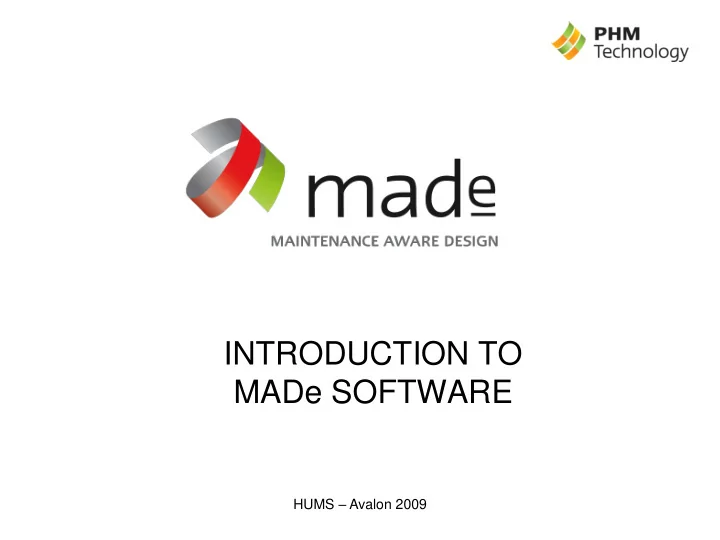

INTRODUCTION TO MADe SOFTWARE HUMS – Avalon 2009
Background • PHM Technology is an Australian company focused on advanced engineering applications. • The ‘Maintenance Aware Design environment’ (‘MADe’) is a software tool that meets the practical engineering requirements for reliability & PHM system design, assessment and management. • Only private company to secure a JSF Science and Technology Board R&D grant [to develop the ‘Aerospace PHM Software Tool based on MADe] HUMS – Avalon 2009
What is MADe? • The Maintenance Aware Design environment (‘MADe’) is a software tool that meets the practical engineering requirements for reliability / HUMS / PHM system design and management, including: – detailed failures databases for systems based on standardized taxonomies with user configurable outputs – dependency modeling: effects of failures are accurately propagated through complex hierarchical systems – trade study analysis and assessment of system coverage of sensor set design based on FMECA – advanced diagnostic capability, including Fault Detection & Isolation / False Alarm mitigation HUMS – Avalon 2009
MADe Features • MADe provides: – generic and proprietary libraries (re-usable parts and extensible component / system elements) – design of HUMS / PHM systems based on FMECA (what-if analysis conducted in real-time based on user defined parameters, eg. cost, weight, reliability, etc.) – performance assessment of legacy HM systems (failure mode coverage based on existing sensor sets) – design version controls (multiple concurrent system versions to meet internal / customer specific requirements) HUMS – Avalon 2009
MADe Overview HUMS – Avalon 2009
Customer Outcomes Implementation of MADe to: 1. optimise system design (reliability) 2. reduce design costs & risks 3. reduce compliance costs (documentation) 4. standardise design process (concurrent) 5. improve condition / health monitoring capability 6. accelerate product development lifecycle 7. Quality Assurance for supply chain 8. reduce Life Cycle Costs Summary – optimise design, reduce costs & risks HUMS – Avalon 2009
MADe - Business Case • reduces time taken to create, update and maintain accurate failures database – reduce design cost • supply chain failures data is often redone, eliminates replication of effort – reduce process cost • verification and validation of sensor set designs improves health monitoring – increase reliability • improving system reliability during operations leads to reduction in total operating costs – reduce life cycle costs (LCC) HUMS – Avalon 2009
Module MADe Failure Database Generate a complete list of failure modes and effects Concept stage Assess criticality of failures and faults Generate database of faults and failures for other applications (e.g. MBR) ‘What if?’ analysis (e.g. effects of system modifications) Verify failure modes, effects and criticality for existing or legacy systems Post design Update list of failure modes and effects for a modified system Verify results obtained from Model-Based Reasoners Automated analysis eliminates errors and omissions Features Speed, ease, efficiency Enables concurrent design practices (Maintenance Aware Design) Re-useable, scalable system models HUMS – Avalon 2009
Module MADe Performance Assessment Concept stage Assess predicted performance of a PHM design against specifications Conduct ‘what - if?’ analysis for PHM capability vs. design trade -offs for weight, cost etc. Identify additional PHM requirements for system design modifications Verify the failure coverage of existing sensor set designs Post design Test diagnostic capability of other programs, e.g. Model-Based Reasoners Verify results obtained from Model-Based Reasoners On-screen, real-time analysis results facilitates decision making Features Automatically generate validation and support documentation Accommodate Built-In-Tests, evaluate virtual sensing capability FMECA based approach to failure coverage assessment HUMS – Avalon 2009
Module MADe Design Optimisation Concept stage Assessment of anticipated PHM requirements for system designs and design variations Conceptual design of PHM system in terms of sensor types Optimisation of total number and location of sensors Post design ‘What - if’ analysis to determine impact of trade -offs (e.g.: weight, cost etc.) on PHM capability Ranking of potential sensor set designs in terms of total weight, cost etc. FMECA - based approach to sensor placement Features On-screen, real-time results for trade studies Automatic audit trail and documentation of PHM design iterations HUMS – Avalon 2009
Module MADe Diagnostic Concept stage Design diagnostic application for a system to detect and localise failures Design prognostic application able to predict likelihood of failures Validate results from MBR and other diagnostic/prognostic tools Post design Provide real-time, on-board FDI capabilities Ability to rapidly update application based on revised FMECA (system upgrades) Features ‘Bottom up’ approach provides efficient software – smaller code and processing requirements HUMS – Avalon 2009
Recommend
More recommend